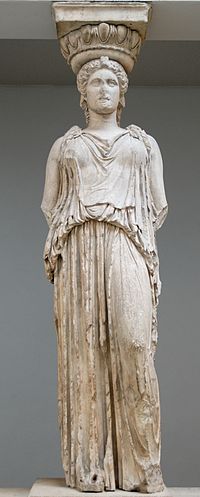222:, the zone is used as a sign of their sexual maturity, since pre-pubescent girls do not wear them. However, younger girls do wear zones, but an unbelted version of it. Adult women who are unmarried wear a belted version of the zone which signifies their virginity. The process of the bride tying the belt's knot prior to the wedding is symbolic of her readiness for marriage. The belt is meant to be removed by their husband on their wedding night. A married woman still uses a zone, and also a belted version, though it looks different from the one used by an unmarried woman. The belts are only removed during their pregnancy and childbirth.
20:
44:
205:, mandating that the vestments of Old Believer clergy be sufficiently different from those of clergy belonging to the State Church, in order to avoid confusion.
201:
of the
Russian Tradition, have a unique design, with four pendant strips, two on each hip. This was the result of legislation passed under Empress
391:
269:, appeared with her zone and "silvery raiment". The zone is also used as a way to maintain female agency, where the zone is used by
354:
376:
286:
386:
401:
396:
291:
274:
138:
381:
142:
245:
depicting female mythological figures. It is often used to symbolize female sexuality, such as when
233:) do not wear belts. The male foreigners, however, do, and this signifies their lack of manliness.
134:
160:
in the center, with long ribbons at the ends for tying around the waist. It is worn over the
177:
71:
8:
202:
350:
306:
296:
242:
344:
219:
157:
118:
106:
277:
as a way to commit suicide when the alternative is to enter unwanted matrimony.
19:
230:
169:
91:
79:
59:
32:
90:) girdle and can also refer to the waist itself. Classical Greek had a verb (
370:
198:
165:
16:
Vestment; form of girdle or belt common in the ancient eastern
Mediterranean
28:
154:
183:
The zone is not worn for services when the priest is not fully vested,
161:
150:
270:
226:
50:
belt in the
Russian edition of Reallexikon des classischen Alterthums
266:
173:
122:
43:
317:
258:
187:
146:
311:
301:
262:
191:
130:
126:
36:
24:
254:
75:
250:
246:
102:) put a girdle around the loins, or "gird one's self."
70:) is a form of girdle or belt common in the ancient
225:At the same time, female foreigners (also known as
168:and keeps them in place as the priest performs the
368:
346:Body, Dress, and Identity in Ancient Greece
213:
42:
18:
172:. In this regard it is similar to the
369:
392:History of clothing (Western fashion)
338:
336:
334:
208:
342:
13:
14:
413:
331:
253:, while wearing her zone in the
236:
197:The zone worn by priests of the
343:Lee, Mireille M. (2015-01-12).
349:. Cambridge University Press.
1:
324:
287:Clothing in the ancient world
7:
377:Eastern Christian vestments
280:
10:
418:
292:Clothing in ancient Greece
139:Oriental Orthodox Churches
241:The zone has featured in
143:Eastern Catholic Churches
95:
83:
63:
35:). Note the blousing, or
261:, as she was created by
135:Eastern Orthodox Church
74:. The term occurs in
51:
40:
249:seduced her husband,
214:Cultural significance
178:Roman Catholic Church
72:Eastern Mediterranean
46:
22:
314:worn by Zoroastrians
105:In modern Greek and
78:, for instance, as (
387:History of clothing
220:ancient Greek women
203:Catherine the Great
109:the zone or (Пояс,
402:Byzantine clothing
397:History of fashion
117:) is a liturgical
52:
41:
356:978-1-107-05536-0
320:worn by Mandaeans
275:Suppliant Maidens
209:In ancient Greece
145:. It is made of
23:Caryatid wearing
409:
382:Belts (clothing)
361:
360:
340:
307:Zoster (costume)
297:Chiton (costume)
243:Greek literature
97:
85:
65:
39:, over the Zone.
417:
416:
412:
411:
410:
408:
407:
406:
367:
366:
365:
364:
357:
341:
332:
327:
283:
239:
216:
211:
107:Church Slavonic
17:
12:
11:
5:
415:
405:
404:
399:
394:
389:
384:
379:
363:
362:
355:
329:
328:
326:
323:
322:
321:
315:
309:
304:
299:
294:
289:
282:
279:
238:
235:
231:ancient Greece
215:
212:
210:
207:
170:Divine Liturgy
33:British Museum
15:
9:
6:
4:
3:
2:
414:
403:
400:
398:
395:
393:
390:
388:
385:
383:
380:
378:
375:
374:
372:
358:
352:
348:
347:
339:
337:
335:
330:
319:
316:
313:
310:
308:
305:
303:
300:
298:
295:
293:
290:
288:
285:
284:
278:
276:
272:
268:
264:
260:
256:
252:
248:
244:
237:In literature
234:
232:
228:
223:
221:
206:
204:
200:
199:Old Believers
195:
193:
189:
186:
181:
179:
175:
171:
167:
166:epitrachelion
163:
159:
156:
152:
148:
144:
140:
136:
132:
128:
124:
120:
116:
112:
108:
103:
101:
93:
89:
81:
77:
73:
69:
61:
57:
49:
45:
38:
34:
30:
26:
21:
345:
240:
224:
217:
196:
184:
182:
114:
110:
104:
99:
87:
67:
55:
53:
47:
151:embroidered
29:Erechtheion
371:Categories
325:References
227:barbarians
162:sticharion
121:worn as a
100:zōnnysthai
271:Aeschylus
155:appliquéd
96:ζώννυσθαι
27:from the
281:See also
267:Theogony
174:cincture
164:and the
149:with an
123:vestment
318:Himiana
259:Pandora
188:vespers
176:of the
147:brocade
133:of the
131:bishops
127:priests
353:
312:Kushti
302:Peplos
263:Athena
192:matins
37:Kolpos
25:peplos
255:Iliad
158:cross
111:poyas
92:Greek
88:zonēn
84:ζώνην
80:Greek
76:Homer
60:Greek
351:ISBN
251:Zeus
247:Hera
218:For
185:e.g.
141:and
129:and
119:belt
115:belt
68:zōnē
64:ζώνη
56:zone
54:The
48:Zone
265:in
257:or
229:in
190:or
153:or
125:by
373::
333:^
273:'
194:.
180:.
137:,
113:-
98:,
94::
86:,
82::
66:,
62::
359:.
58:(
31:(
Text is available under the Creative Commons Attribution-ShareAlike License. Additional terms may apply.

